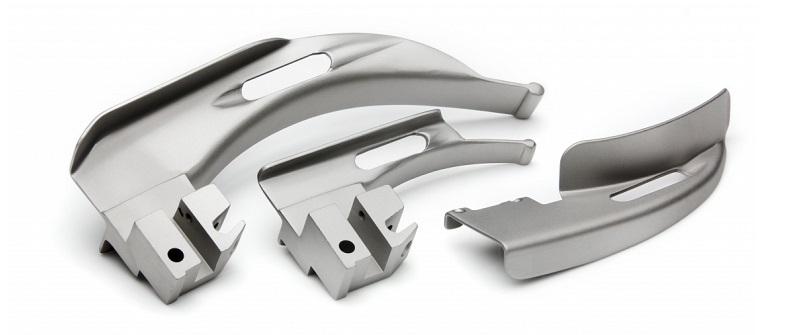Sterilising surfaces is necessary in various industries and applications where maintaining a high level of cleanliness and preventing microbial contamination is crucial.
In the medical industry sterilisation helps prevent infection, whilst in the food processing and pharmaceutical industries it maintains product safety and prevents contamination. Sterilisation is also crucial for laboratories, research settings, cleanrooms, controlled environments and public and shared spaces.
Note that wet blasting alone will not achieve complete sterilisation but enhances and improves the effectiveness of subsequent sterilisation steps. For thorough sterilisation, it is essential to employ dedicated sterilisation methods, such as chemical disinfection, autoclaving, or other appropriate techniques, depending on the specific requirements and applications.

Medical industry Larynscope blades wet blasted to a specific Ra that is perfect for sterilisation
Metal Surfaces: Wet blasting (or vapor blasting) offers several major benefits when it comes to sterilising metal surfaces (scroll down for the benefits of sterilising composite surfaces by sterilisation), including:
Enhanced Cleaning: Wet blasting effectively removes contaminants, dirt, grease, rust, and scale from metal surfaces. By thoroughly cleaning the surface, it eliminates potential sources of microbial contamination and provides a cleaner base for sterilization processes.
Increased Surface Area: The wet blasting process creates a slightly roughened surface on the metal, increasing the surface area available for sterilising agents to interact with. This can enhance the effectiveness of subsequent sterilisation methods, such as chemical disinfection or heat treatments.
Uniform Surface Preparation: Wet blasting can provide a more uniform and consistent surface finish compared to other cleaning methods. This uniformity helps in achieving better coverage and distribution of sterilizing agents, ensuring that all areas of the metal surface are adequately treated.
Removal of Biofilms: Biofilms are slimy microbial communities that can form on metal surfaces. They can be challenging to eliminate, as they provide protection and shelter for micro-organisms. Wet blasting can help remove biofilms by physically dislodging and breaking them apart, facilitating easier access for sterilising agents to reach and destroy any remaining micro-organisms.
Reduced Surface Damage: Compared to more aggressive cleaning methods like dry sandblasting, wet blasting is generally gentler on metal surfaces. It reduces the risk of causing surface damage, such as scratches, pitting, or corrosion, which can create niches for microbial growth. Minimising surface damage promotes better sterilisation and reduces the potential for future contamination.
Optimum Ra Surface Roughness: Typically, dry-blasting creates a surface with 1.3µm Ra – well above the European Hygienic Engineering and Design Group’s (EHEDG) acceptable limit. However, wet blasting with glass beads leaves a surface roughness typically between 0.25 and 0.6µm Ra – the optimum surface Ra for instruments that need to be perfectly sterilised. A surface roughness of less than 0.25 µm Ra is suboptimal because microbes can effectively 'stick' to the surface, while a surface above 06µm Ra creates a larger surface area for microbes to populate.

Medical, pharmaceutical laboratory, and food preparation metal surfaces
Composite Surfaces: Wet blasting (or vapor blasting) offers several major benefits when it comes to sterilising composite surfaces, including:
Surface Cleaning and Decontamination: Wet blasting effectively removes contaminants, residues, and organic matter from composite surfaces. By thoroughly cleaning the surface, it eliminates potential sources of microbial contamination, making it easier to achieve effective sterilisation.
Enhanced Surface Texture: Wet blasting can create a controlled and uniform surface texture on composites. This texture can increase the surface area available for sterilisation agents to interact with, enhancing the effectiveness of subsequent sterilisation methods.
Improved Penetration: The wet blasting process can open up micro-pores and surface imperfections on the composite, allowing sterilisation agents to penetrate deeper into the material. This is particularly beneficial for porous composites where sterilisation agents may have difficulty reaching hidden micro-organisms.
Mechanical Activation: Wet blasting can mechanically activate the surface of composites, promoting increased reactivity and adhesion of sterilisation agents. This activation can help ensure better contact between the sterilisation agents and the composite surface, improving the efficiency of the sterilisation process.
Uniform Treatment: Wet blasting provides a more uniform and consistent surface preparation compared to other cleaning methods. This uniformity allows for better coverage and distribution of sterilisation agents, ensuring that all areas of the composite surface are adequately treated.
Minimized Surface Damage: Wet blasting is generally gentler on composite surfaces compared to aggressive cleaning methods, reducing the risk of surface damage such as delamination, fibre damage, or surface roughness. By minimizing surface damage, wet blasting helps maintain the structural integrity of the composites while facilitating effective sterilisation.
In addition to the benefits of wet blasting (or vapor blasting) metal and composite surfaces for sterilisation mentioned above, there are many additional benefits to wet blasting surfaces that are related to the cleanliness and sterilisation of surfaces, for example, burr removal and the creation of non-reflective surfaces for medical instruments. Visit our industry and the rest of our application pages to discover the benefits of wet blasting that relate to specific industries and applications.